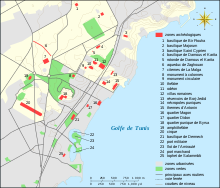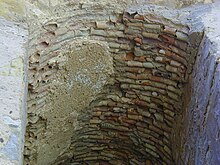Basilica of Damous El Karita


The basilica of Damous El Karita is a Tunisian basilica, located in Carthage, dating from the Late antiquity and the Byzantine epoch. It is situated nearby the Odeon hills within the archeological site of Carthage.
Most important and known Christian architectural complex within the capital of the
The importance of the complex suggests that the place was not only a funerary center but also a major pilgrimage site linked to the cults of the saints buried in this place as well as of important religious festivals.
The identification of the basilica is complex but, following recent works, some authors accept the identification with a basilica known by literary sources as the basilica Fausti .
Etymology
The current name of the basilica comes from a deformation of the latin domus caritatis or "house of charity".[3]

Plan
The ensemble as of the 1990s is still incompletely searched.[2] The known surface of the complex is, however of 15000 m2 from which 2925 m2 constitutes the quadratum populi.[4]
Basilica

The most massive element of the complex is a church with nine (then eleven[2]) naves, from which the largest mesures 12.80 metres[5] and eleven bays whose pillars have Corinthian capitals, the barrels of the columns are made out of green marble and the bases out of white marble. The main building is oriented South-West- North-East[5] and mesures 65 metres over 45.
Rotunda


The most important element of the known appendices is located in the southwest : It is a subterran rotunda, having an interior diameter of 9.15 metres [6] with a cupola. Two symmetrical stairs,[7] vaulted and in square[4] permit the access ; the ceiling is still partially covered with tubes of terracotta. The corridor is 10.40 metres long and forms an angle before giving access to the underground room.[7] In the past, one corridor permitted entry while the other permitted exit according to Delattre and based on the interpretation of a mosaic found nearby.[8]

References
- ^ Noël Duval, « Études d’architecture chrétienne nord-africaine », Mélanges de l’École française de Rome: Antiquité, vol. 84, n°84-2, 1972, pp. 1107-1108
- ^ a b c Noël Duval, « Les monuments de culte chrétien et les cimetières [de Carthage] », Encyclopédie berbère, tome XII, éd. Edisud, Aix-en-Provence, 1993, p. 1808
- ^ André Laronde et Jean-Claude Golvin, L’Afrique antique, éd. Taillandier, Paris, 2001, p. 176
- ^ a b Paul Corbier et Marc Griesheimer, op. cit., p. 279
- ^ a b Alfred Louis Delattre, La Basilique de Damous El-Karita à Carthage, p. 6
- ^ Noël Duval, « Études d’architecture chrétienne nord-africaine », p. 1113
- ^ a b Alfred Louis Delattre, « Les fouilles de Damous-el-Karita », p. 474
- ^ Alfred Louis Delattre, « Les fouilles de Damous-el-Karita », pp. 475-476
